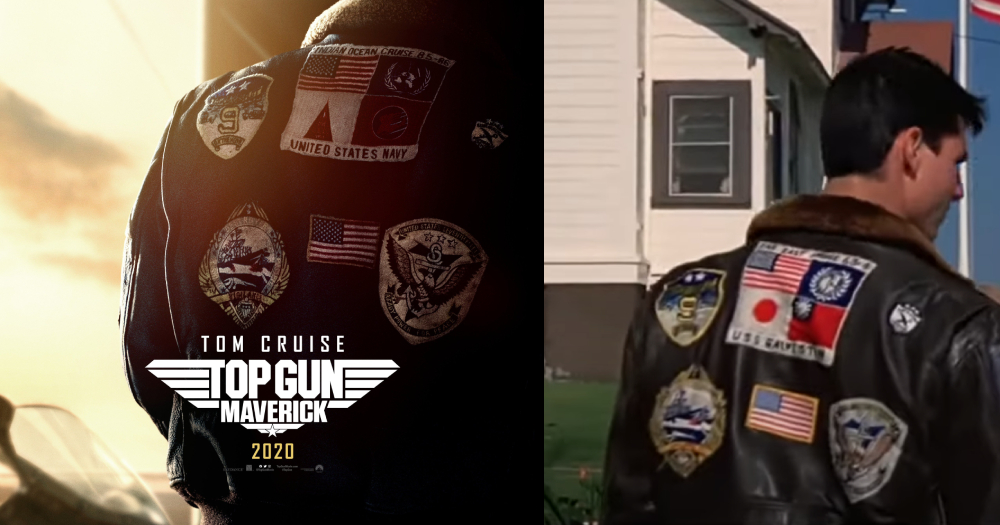Follow us on Telegram for the latest updates: https://t.me/mothershipsg
Fans of Tom Cruise’s new film, "Top Gun: Maverick", might have noticed that the flags of Taiwan and Japan had been restored to the film’s iconic aviation jacket.
Some noticeable changes
Tom Cruise’s protagonist, Pete “Maverick” Mitchell, wore an aviation jacket with a large commemorative patch sewn onto its back, memorialising a voyage undertaken by his father who had also been a pilot with the U.S. navy, and had gone missing after a combat mission during the Vietnam war.
The patch appears to have been inspired by a real 6-month operational deployment by the USS Galveston, where the ship had visited both Taiwan and Japan in 1963 and 1964.
When the movie’s first trailer and poster were released in 2019, avid fans noticed that the patch had been significantly altered.
Check out the official poster for #TopGun: Maverick starring @TomCruise. In theatres 2020. pic.twitter.com/5emkDH9j5f
— Top Gun (@TopGunMovie) July 18, 2019
Where the American and United Nations flags remained, Taiwan and Japan’s flags had been replaced with symbols that have no apparent meaning but retains similar colouration that is present in the flags.
Taiwan 🇹🇼 flag spotted in #TopGunMaverick, premiers in Taiwan today https://t.co/hFzOE6q91U pic.twitter.com/SkVxugE4rk
— Taiwan News (@TaiwanNewsEN) May 25, 2022
Taiwanese movie goers cheered
For their part, many Taiwanese movie goers cheered when they saw that Taiwan’s flag had been restored in the release version of the movie, according to Vice, citing Central News Agency.
Although not formally acknowledged, it was suspected that the changes had been undertaken in order to allow the movie to be screened in China, which only allows 34 foreign movies a year to be shown in theatres.
The original "Top Gun" movie is known as a flag waving, pro-American romp that was filmed with significant U.S. Navy support. This might lead some to conclude that the movie’s sequel is unlikely to do well in China, where rising nationalism can be observed.
However, it appears that the movie has a deep rooted fandom in China, with several China-centric remakes having been attempted, to mixed reviews.
Tencent's investment and subsequent withdrawal
Reporting by the Wall Street Journal also revealed that Paramount Pictures had received a US$170 million (S$234 million) investment from Tencent Holdings in the sequel, in exchange for a 12.5 per cent stake in the movie.
The timing of this investment came at around the same time as the removal of the flags from the 2019 trailer, sparking speculation that the change was due to pressure from Tencent to adhere to the Chinese government's guidelines.
However, the tech company later backed out in late 2019. Tencent had likely not wanted to appear unpatriotic at a time when China’s government was demanding more visible loyalty from its corporate citizens.
Movie unlikely to be released in China
Tencent’s investment in movies is symbolic of the rocky relationship between Hollywood and China.
When China began to open to the West, American movie studios saw the country as an untapped source of ticket buyers. But as China’s companies found their footing, they began to use their financial clout to invest in the American movie industry.
However, these investors began to bring along their political sensitivities to creative decisions in order to pass China’s increasingly strict censors. This has led American commentators and academics to worry about China's growing influence on the movie industry in the U.S., and to accuse filmmakers of selling out to China.
Tencent's withdrawal and increasing Sino-U.S. friction makes "Top Gun: Maverick’s" release in China unlikely, prompting the return of Taiwan and Japan’s flags to the movie.
The movie has also altered the narrative on American filmmakers’ dependence on China, and it is likely to achieve profitability without a Chinese market release.
Read more:
Top image via @TopGunMovie/Twitter & Top Gun
If you like what you read, follow us on Facebook, Instagram, Twitter and Telegram to get the latest updates.
